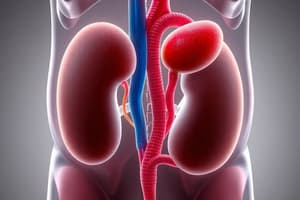Podcast
Questions and Answers
What anatomical feature connects the apex of the urinary bladder to the umbilicus?
What anatomical feature connects the apex of the urinary bladder to the umbilicus?
- Round ligament
- Median umbilical ligament (correct)
- Urachus
- Falciform ligament
What structure is located posterior to the bladder in males?
What structure is located posterior to the bladder in males?
- Vagina
- Ileum
- Cecum
- Rectum (correct)
Which area of the bladder is known for being smooth and devoid of rugae?
Which area of the bladder is known for being smooth and devoid of rugae?
- Apex
- Inferior angle
- Fundus
- Trigone (correct)
Which part of the bladder gives rise to the urethra?
Which part of the bladder gives rise to the urethra?
What is the relationship of the urinary bladder to the abdominal cavity as it fills?
What is the relationship of the urinary bladder to the abdominal cavity as it fills?
What anatomical feature contributes to the movement of urine through the ureters?
What anatomical feature contributes to the movement of urine through the ureters?
At which site does the ureter have a physiological sphincter to prevent backflow of urine?
At which site does the ureter have a physiological sphincter to prevent backflow of urine?
Which of the following correctly describes the relations of the right ureter?
Which of the following correctly describes the relations of the right ureter?
Which anatomical difference regarding ureters in males versus females is accurately described?
Which anatomical difference regarding ureters in males versus females is accurately described?
What is the length of the ureter, and what might impact its function?
What is the length of the ureter, and what might impact its function?
Flashcards are hidden until you start studying
Study Notes
Ureter
- Muscular tube, 25-30 cm long and 3-4 mm in diameter.
- Extends from kidneys to the urinary bladder.
- Transports urine from kidneys to the bladder.
- Urine movement:
- Peristaltic contractions (1-5/min).
- Hydrostatic pressure and gravity.
- Ureter course in the abdomen:
- Starts at the hilum of the kidney, as a continuation of the renal pelvis.
- Descends retroperitoneally on the Psoas muscle.
- Crosses the bifurcation of the common iliac artery at the pelvic brim to enter the pelvis.
- Produces a kink as it crosses the pelvic brim.
- Ureter course in the pelvis:
- Runs downward and backward on the lateral wall of the pelvis towards the ischial spine.
- Turns forward to enter the posterolateral angle of the bladder.
- Gender differences:
- Male: crossed by the vas deferens superomedially near its termination.
- Female:
- Passes behind the ovary.
- Crosses medial to the origin of the uterine artery and below the broad ligament of the uterus.
- Risk of injury during uterine artery ligation in hysterectomy procedures.
- Relations of the right ureter:
- Anteriorly:
- Second part of the duodenum.
- Right gonadal vessels.
- Right colic and ileocolic vessels.
- Posteriorly:
- Right Psoas muscle.
- Bifurcation of the right common iliac artery.
- Anteriorly:
- Relations of the left ureter:
- Anteriorly:
- Left gonadal vessels.
- Left colic vessels.
- Sigmoid colon.
- Posteriorly:
- Left Psoas muscle.
- Bifurcation of the left common iliac artery.
- Medially: inferior mesenteric vein.
- Anteriorly:
- Constrictions of ureter:
- Potential sites of obstruction by ureteric stones.
- Occur at:
- Ureteropelvic junction.
- Pelvic brim.
- Ureterovesical junction.
- Peristaltic contractions ensure unidirectional flow of urine.
Urinary Bladder
- Hollow muscular organ in the pelvic cavity.
- Situated posterior to the pubic symphysis.
- In adults:
- Completely in the pelvic cavity when empty.
- Extends into the abdominal cavity when full.
- Lower level in females due to the absence of the prostate gland.
- Shape:
- Pyramidal (apex, base, and 3 surfaces) or pear-shaped when empty.
- Apex:
- Pointed anteriorly.
- Behind the upper margin of the pubic symphysis.
- Connected to the umbilicus by the median umbilical ligament.
- Median umbilical ligament: remnant of the urachus.
- Urachus: remnant of the allantois.
- Allantois: duct that carries urine from the fetus's body to the umbilical cord.
- Base (Fundus):
- Faces posteriorly.
- Triangular in shape.
- Superior angles joined by ureters.
- Inferior angle (neck) gives rise to the urethra.
- Superior part covered by peritoneum.
- Structures on the bladder base:
- Male:
- Vasa deferentia pass medially to the seminal vesicles, separating the bladder from the rectum.
- Retrovesical fascia and fat.
- Rectovesical (retrovesical) pouch: peritoneal fold between the bladder and rectum, the lowest point in the abdomen.
- Female:
- Vagina posterior to the bladder, separating it from the rectum.
- Rectouterine pouch: peritoneal fold between the uterus and rectum.
- Male:
- Superior surface:
- Separates the bladder from:
- Male: coils of ileum and sigmoid colon.
- Female: the body of the uterus.
- Uterovesical pouch: peritoneal fold between the uterus and the superior surface of the bladder.
- The bladder bulges upwards into the abdomen when full, becoming ovoid.
- Separates the bladder from:
- Two inferolateral surfaces.
- Internal structure:
- Folded into rugae when empty.
- Rugae disappear when full.
- Except over the internal surface of the base (trigone).
- Trigone:
- Smooth mucous membrane adherent to the underlying muscular layer.
- Superior angles: ureters, connected by the interureteric ridge.
- Inferior angle: urethral orifice, protected by the internal urethral sphincter.
- Innervation:
- Sympathetic: L1 and L2 ganglia of the sympathetic trunk.
Studying That Suits You
Use AI to generate personalized quizzes and flashcards to suit your learning preferences.



